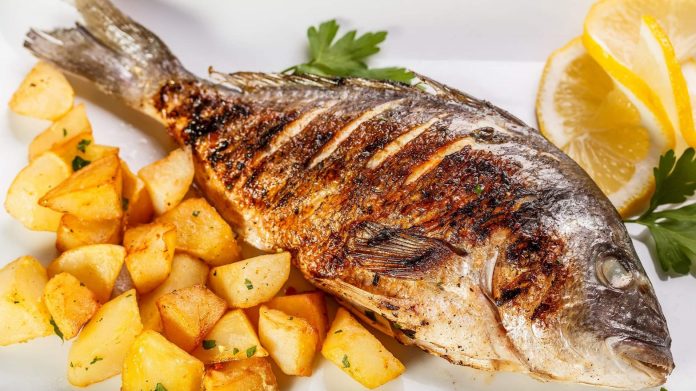Plucked from the sea or reared and cultivated on the land according to traditional methods, Croatian fish, meat and vegetables are then prepared with extra virgin olive oil, on wood-fired grills, on road-side spits and beneath slow-roasting, dome-shaped lids.
The result is a simple but delicious Mediterranean cuisine that you can expect to find the length and breadth of Dalmatia. Istria has its own regional specialities, as does Zagreb.

Antonio Truzzi
Crni rižot
Listed on nearly every Dalmatian menu, ‘black risotto’ is far more tasty than it sounds – or looks. Squid ink provides the distinctive colouring and satisfying flavour, squid and other seafood the meaty ingredients. Make sure you’re familiar with your dining companion as this is the kind of dish that turns your teeth and tongue black – not great for a first date – but as crni rižot is usually prepared that morning and heated up, it’ll arrive much quicker than something that might require time on the grill.2

Mario Zupancic
Fritule
Christmas wouldn’t be Christmas without fritule, little battered doughnut balls dusted with powdered sugar and filled with rum and raisins. Different households may add a touch of lemon zest or grated orange peel here and there, but the key here is sharing. Fritule are not exclusive to the season of goodwill, but available most of the year round as a special treat.
3

Gregada
A fish stew most associated with the island of Hvar, though you’ll find similar versions across Dalmatia, gregada is often made with scorpion fish or grouper – whatever is fresh that day is chopped into large chunks and added to a pot of generously sliced potatoes and lashings of olive oil. Chefs then add their own extras, usually parsley, but all simmer the pot on a slow heat, shaking it from time to time, keeping the chunks whole. Serve with wine and a winning sunset.4

© Konavoski Dvori National Restaurant
Ispod peke
Ispod peke, literally translated as under the bell, is a classic feature on many Dalmatian menus. It’s not a dish, it’s a method of preparation involving slow- cooking under a dome-shaped lid, covered in hot ashes. For a proper peka meal, you should order from the restaurant that morning or even a day in advance. Typically, you can choose from octopus, lamb or veal, but other meats and fish are often on offer. The distinctively succulent flavours are unique, complemented by a substantial serving of potatoes. Bring an appetite.
5

Ulana Horunža
Istrian truffles
In Istria truffles are more than just a cottage industry – they’re big business. Look out for restaurants with the tartufo vero sign, which means they’ve met Istria’s high standards for handling and serving the delicacy. In Livade, weekends in October see the judging of the best truffle, cookery classes and truffle auctions. Here you’ll find Istria’s most famous truffle restaurant, Zigante.6

Dario Vuksanović
Kulen sausage
Slavonian kulen is made by hand from special cuts of top quality pork sourced from mature pigs, and takes nine months to cure naturally. It’s dry, spicy and when sliced has the same saturated colour and distinctive texture throughout – the only additives are salt, garlic and red paprika. At summer’s kulen festivals, kulenijada, notably in Vinkovci, the previous year’s batch reaches perfection.
7

Kvarner scampi
Scampi from Kvarner Bay are considered the best in this part of Europe. In Istria as well as Kvarner you’ll find them boiled, grilled, prepared in sauce, marinated, breaded, wrapped in Istrian ham, spit-roasted and even raw, embellished by first-class olive oil.8

Dušan Zidar
Olive oil
Like wine, Croatia’s olive-oil cultivation dates back to Roman times. And, like wine, for decades the industry was nationalised and standardised for the benefit of quantity over quality. In Istria, in particular, a new, independent generation has developed the production of small-batch, high-quality, extra-virgin olive oil. The Istrian Tourist Board has even produced a route map so that you can visit these family-run groves – the map will lead you to tiny villages and hamlets, many set in spectacular landscapes.
9

TB Ston
Oysters
Croatian oysters have a more intense flavour than their Atlantic counterpart. The most renowned varieties come from Ston on Pelješac in Dalmatia, and the Limski kanal in Istria. In both lesser-visited locations, the adventurous traveller will be rewarded by finding casual vendors purveying divine oysters by the side of the road or from a makeshift outlet, as fresh as it gets.10

Natalia Bratslavsky
Pag cheese
Local sheep grazing in the salty air, Bura wind and on vegetation particular to Pag produce milk of a flavour equally specific to this island in northern Dalmatia. Sheeps’ cheese has been produced here for centuries, generations of expertise going into each distinctive wheel you see lining the shelves of the traditional stone houses dotted alongside the fields.
Matured for up to 18 months, similar in texture to Parmesan, these cheeses are then sold at markets and to restaurants, where paški sir is a regular feature as a starter or dessert. More







